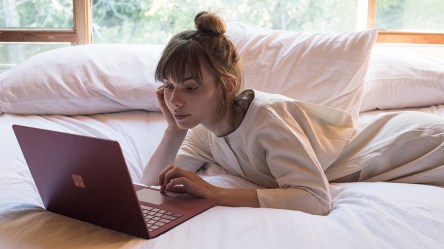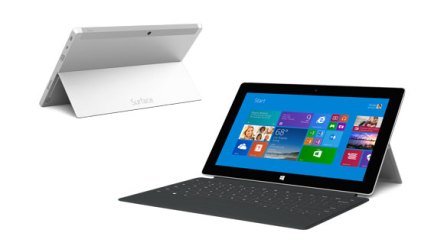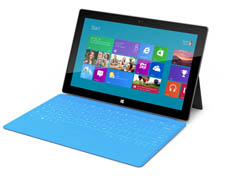Microsoft’s Surface lineup welcomed its newest computer, the Surface Laptop, the company’s direct answer to the MacBook. The new flagship device for Windows 10 S was designed with college students in mind. It will sell starting at $999 (upgraded versions will costs as much as $2,199) and will begin shipping on June 15. The new device doesn’t hold any records—it’s not the thinnest nor lightest out there, but its 0.6-inch thickness and 2.74-pound weight make it an easy burden to carry around. The Surface laptop doesn’t bring any novelties either, it’s a Microsoft PC with the Surface branding. The overall design makes you think more about a MacBook-style notebook rather than a Microsoft’s Surface Book—the screen is not detachable and the hinges are not supposed to be seen. In fact, the Surface Laptop feels to be geared toward Apple customers more than anyone else. It will be available in four colors—burgundy, graphite gold, platinum and cobalt blue—the burgundy and blue versions are special in a way that will immediately stand out. Out stands the cloth-like Alcantara fabric, brought from Italy and is laser cut to coat the palm rests and the space between the keys. Even though it’s not more luxurious than metal, its softness and warmth look appealing. How well will it stand the test of time? Remains to be seen. Tech-specs wise, one of the first things that catches your eye is its lack of ports (which seems to have turned into a trend lately): the headphone jack is still there, next to an USB 3.0 port and a mini DisplayPort. But that’s it, Microsoft decided that the USB-C doesn’t have a place there, nor does Thunderbolt 3. One cool thing is that it doesn’t have any visible speaker grilles or holes,...
2 New Surfaces
Updated Microsoft tablets
Microsoft’s latest tablets, Surface 2 and Surface Pro 2, are now on the market with a number of new covers and other accessories (dock, mouse, and charger). Both tablets seem like iterations of the concept Microsoft first demonstrated last summer. They kept the same angular design with metallic finish, announcing upgrades to the processing power and battery life, to the display and camera resolution. Enhancements in Windows RT 8.1 and Windows 8.1 Pro promise to make the two tablets more powerful and customizable. Surface 2 The lower-priced ARM received a 1.7GHz Nvidia Tegra 4 processor and 2GB of RAM and flipped the 1366×768 screen with one of 19290×1080 with better color accuracy. Basically Microsoft addressed two of the most complained about features of the predecessor – weak performance and low screen resolution. The Surface 2 is just a bit thinner and slightly lighter than the previous version, with 25 percent more battery life and a USB 3 port. The cameras are improved to 3.5MP for the front and 5.0MP for the rear for Skype and other webcam uses. To differentiate it from the more powerful brother, the Surface 2 tablet will only be available in a silver/magnesium color with just the front surface still retaining the black bezel. It looks good and feels more comfortable, but the main concern remains the software; it’s clear that Microsoft patched some holes and added some much-needed functionality to the mix, and the number of apps in the Windows Store is rising (there are now over 100,000 apps), but the fact that this version of Windows can’t run the same apps and perform as well as the full-blown Windows might be a momentum killer. Interesting about the two tablets are the keyboard covers (Touch Cover, Type Cover and...
Surface Tablet
Competition for the iPad
Earlier this month, Microsoft pulled an Apple move and debuted its new Surface tablet to a hushed crowd of tech media bigwigs. It had all the hallmarks of a classic Steve Jobs production: a rented out art studio space, regal staging, and fanfare designed to shock & ahhh. This aggressive cribbing from the productions that launched the iPad was intentional: Microsoft designed the Surface to compete head-on with Apple and become the market’s first iPad killer. They just might be onto something. And they also may have launched the product that will prompt consumers to decide between a tablet-style device, like a Surface or an iPad, or an ultra lightweight laptop, like an Ultrabook. Price points for Surface are expected to be slightly higher than for the iPad, meaning that it won’t be competing in the same space as Google’s low-cost Nexus Tablet, which is now available for $199, but with the more expensive, high performance Ultrabooks. Surveying the Surface It’s the not-so-little things that stand out so far and make the Surface RT (basic model) and Surface Windows 8 Pro (all-in) look like they might make good on those David vs. Goliath aspirations: It’s got a keyboard. When the Surface keyboard was revealed, you could practically hear a chorus of angels sing and wild cheering from the balconies and the sound of a million hearts shouting forth the virtues of love, peace, and happiness. ‘Cause that’s how stoked people are to have a tablet with a real keyboard. The Touch Cover model gives solid keyboard performance, the Type Cover replicates true keyboard feel. Either way, Surface provides consumers the platform to do a lot more than just send off tweets and emails. It’s bigger. Size matters, and at 10.6 inches the Surface display...



